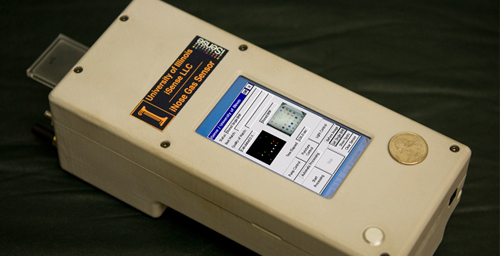The development could lead to the development of cheap and simple devices that could be used for scanning cargo and passengers passing through airports and other places

Chemists from the University of Illinois have developed a simple sensor to detect explosives hidden in shoes. The development could lead to the development of cheap and simple devices that could be used for scanning cargo and passengers passing through airports and other places.
triacetone triperoxide (TATP, Wikipedia) is a powerful explosive used in recent years in several attempted terrorist attacks. This explosive can be easily prepared from the most readily available materials (hydrogen peroxide and acetone) and until now its detection has been a problematic challenge - it is "transparent" to most of the usual chemical sensing methods: it does not glow, is not affected by ultraviolet radiation and is not sensitive to ionization.
The few existing methods for detecting this explosive material are not applicable for ground use in airports, they require large and expensive equipment, careful preparation of the sample or relatively high concentrations of the material in its solid or liquid form. That is, there is no simple method for detecting TATP vapors.
Scientist Kenneth Suslick, professor of chemistry at the University of Illinois, developed a colorimetric sensing system (an analytical method based on obtaining different shades of color, Wikipedia) capable of quantitatively detecting very low levels of the vapors of the substance - down to 2 parts per billion (ppb). The details of the innovative sensor are described in an article published in the scientific journal Journal of the American Chemical Society.
In order to build the array, the researchers printed a series of 16 tiny dots - each one a different color (pigment) - on an inactive plastic surface. A solid acid catalyst breaks down the explosive into its measurable components, which cause the dyes to change color, similar to litmus paper.
Each color changes its color depending on the concentration of the explosive in the air. The array can be digitally displayed using a standard desktop scanner or using an inexpensive electronic camera before and immediately after exposure to the air. "Imagine a sensor the size of a postage stamp capable of sniffing out explosives hidden in shoes simply by using a digital camera that notices the changing colors of the sensor's dots," notes the researcher. The way the color changes constitutes a unique molecular "fingerprint" of TATP for each concentration and we are able to locate it and its amount within a few seconds."
The sensor is uniquely sensitive to TATP. Unlike many other chemical sensors, the innovative device is not affected by changes in humidity or exposure to other substances, such as cosmetics (aftershave, deodorant, hair shampoo) or detergents. In addition, it has a long shelf life, thus allowing the security department at airports, as well as in other places, to be equipped with a large and available quantity of it.
Alongside the researchers' demonstration of their sensing method using a desktop scanner, they also developed a mobile device that is a prototype of the system. The mobile device, suitable for simple scanning of luggage or shoes, consists of cheap white LED lighting components and a standard digital camera similar to the one found in mobile phones. "The ability to carry the device, which is currently in the commercialization stages, yields a mobile, sensitive, fast and cheap process," the researcher notes.
"One of the great advantages of this technology is that it utilizes available and relatively cheap components," said the researcher.

4 תגובות
no control Review. There is a difference and those who cannot make intelligent criticism should not write.
We have an excess of words and an oppressive lack of knowledge.
Yoavhelev:
Indeed, it makes sense that the science website would monitor the work of the University of Illinois lest its scientists get confused, God forbid.
2ppb enough to find TATP in the sole of your shoe?
What I love about these types of sites is the complete lack of criticism.
Is the sensor in question better than the one reported here a few days ago?
https://www.hayadan.org.il/electronic-sensor-for-explosives-0311106/